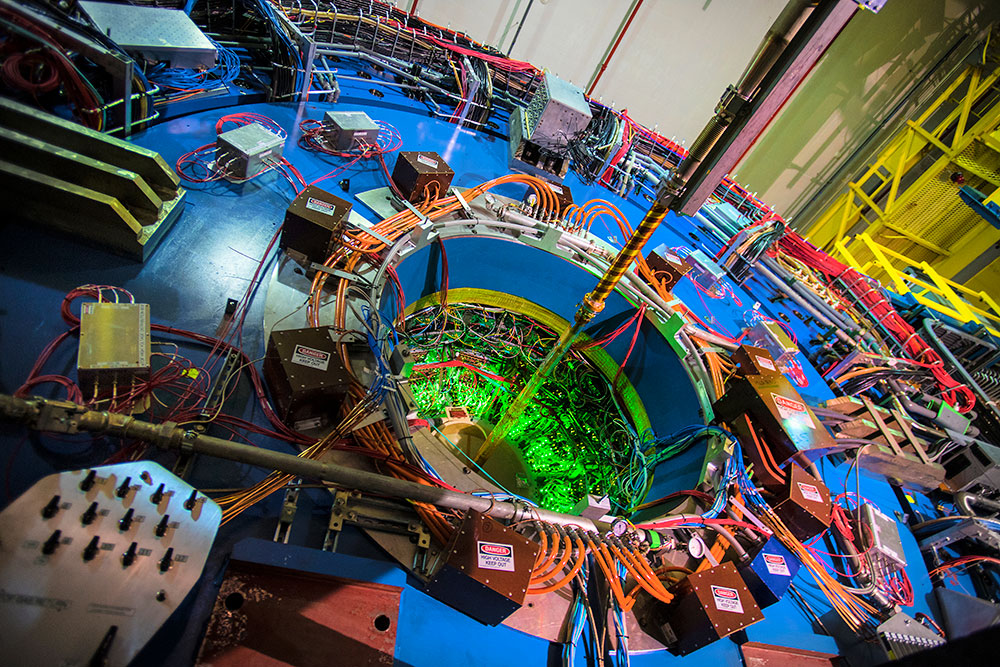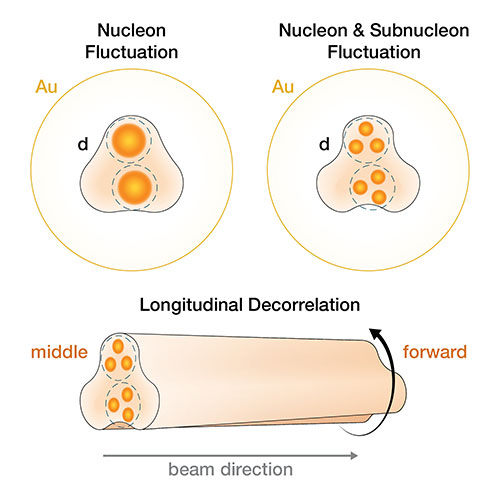New Driver for Shapes of Small Quark-Gluon Plasma Drops?
Results point to importance of internal structure of nucleons—and need for new measurements to disentangle other contributions
June 27, 2023
 enlarge
enlarge
The Solenoidal Tracker at RHIC (the Relativistic Heavy Ion Collider) is a house-sized particle detector more commonly known as STAR. It specializes in tracking thousands of particles that stream out of RHIC collisions. By looking for correlations between pairs of particles emerging from different types of collisions, scientists are gaining new insight into the subatomic building blocks that make up ordinary matter.
UPTON, NY—New measurements of how particles flow from collisions of different types of particles at the Relativistic Heavy Ion Collider (RHIC) have provided new insights into the origin of the shape of hot specks of matter generated in these collisions. The results may lead to a deeper understanding of the properties and dynamics of this form of matter, known as a quark-gluon plasma (QGP).
QGP is a soup of the quarks and gluons that make up the protons and neutrons of atomic nuclei at the heart of all visible matter in the universe. Scientists think the entire universe was filled with QGP just after the Big Bang some 14 billion years ago, before protons and neutrons formed. RHIC, a U.S. Department of Energy Office of Science user facility for nuclear physics research at Brookhaven National Laboratory, creates QGP by colliding the nuclei of atoms at nearly the speed of light. The collisions melt the boundaries of the protons and neutrons, momentarily freeing the quarks and gluons from their confinement within these ordinary nuclear building blocks (collectively called nucleons).
The new analysis of data from RHIC’s STAR detector suggests that the shape of the QGP created in collisions of small nuclei with large ones may be influenced by the substructure of the smaller projectile—that is, the internal arrangement of quarks and gluons inside the protons and neutrons of the smaller nucleus. This is in contrast to publications on data from RHIC’s PHENIX detector, which reported that the QGP shape was determined by the larger-scale positions of the individual nucleons and thus the shapes of the colliding nuclei.
“The question of whether the shape of the QGP is determined by the positions of the nucleons or by their internal structure has been a longstanding inquiry in the field. The recent measurement conducted by the STAR collaboration provides significant clues to help resolve this question,” said Roy Lacey, a professor at Stony Brook University and a principal author of the STAR paper.
As it turns out, the differences in the STAR and PHENIX results may be due to the way the two detectors made their respective measurements, each observing the QGP droplets from a different perspective.
Tracking two-particle correlations
As the STAR collaboration reports in a paper just published in Physical Review Letters, their measurements come from an analysis of particles emerging mostly at the center of their detector, all around the beampipe. By looking at the angles between pairs of particles in this “midrapidity” region, physicists can detect whether there are more particles flowing in particular directions.
 enlarge
enlarge
This illustration shows the interplay of three possible sources of triangular flow in asymmetric collisions such as deuteron-gold: fluctuations in nucleon position (nuclear shape), fluctuations in nucleon position plus their inner quark and gluon constituents, and fluctuations along the beam direction commonly referred to as longitudinal decorrelations.
“You use one particle to determine the direction and use another to measure the density around it,” said Jiangyong Jia, a physicist at Brookhaven Lab and Stony Brook University. The closer the particles are in angles, the higher the density/more particles in that direction.
These flow patterns can be established by pressure gradients associated with the shape of QGP. The STAR team analyzed the flow patterns from three different collision systems: single protons colliding with gold nuclei; two-nucleon deuterons (one proton and one neutron) colliding with gold; and three-nucleon helium-3 nuclei (two protons and one neutron) colliding with gold. The data were collected over three separate runs in 2014 (helium), 2015 (protons), and 2016 (deuterons).
The flow results from PHENIX were based on correlations between particles at midrapidity with particles emitted far out in the forward region of their detector. That analysis found that the specks of QGP and flow patterns established across these three collision systems were associated with the shape of the projectile colliding with the gold nucleus: Spherical protons created circular drops of QGP with uniform flow, elongated two-particle deuterons produced elongated drops and elliptical flow patterns, and roughly triangular three-particle helium-3 nuclei produced triangular blobs of QGP with a correspondingly stronger triangular flow.
“You could see a clear imprint of the shape of the nucleus on the elliptic and triangular flow measurements from PHENIX,” said James Dunlop, the Associate Chair for Nuclear Physics in the Physics Department at Brookhaven Lab.
In contrast, according to Shengli Huang, a Stony Brook University research scientist who led the STAR analysis, “STAR’s ‘v3’ triangular flow patterns were all the same as one another, no matter which projectile we looked at. It seems that the imprint of the triangular shape of the helium-3 nucleus, producing more pronounced v3 flow patterns than the other two systems, is absent. Our findings indicate that nucleon substructure fluctuations play a more important role in determining the QGP shape than do changes in the number of nucleons and their positions.”
Takahito Todoroki, an assistant professor from Tsukuba University, conducted an independent cross-check of the STAR analysis and found the same result.
A question of perspective
“Both sets of measurements from STAR and PHENIX have been rigorously checked by independent teams within both collaborations, and there is no question about the results,” said Dunlop.
Theorists have proposed some explanations.
“While the STAR results can be interpreted as subnucleon fluctuations playing an important role in determining the QGP geometry and smearing out the influence of the triangular shape, and the PHENIX results indicate that the QGP shape is dictated by the nucleon position fluctuations, the experiments are not necessarily inconsistent,” said Brookhaven Lab theorist Bjoern Schenke. “Taking into account the fact that the blob of QGP changes along the longitudinal direction could explain the differences.”
As Jiangyong Jia explained, “When a collision creates QGP, you don’t produce just a slice of QGP; you can imagine it as a cylinder along the beam direction. If you go to the forward end of the cylinder, the geometry might not be the same as if you look right at the middle of this cylinder. There could be a lot of fluctuations along the beam direction.”
Whereas STAR measures at midrapidity, the PHENIX analysis of correlations between particles at midrapidity with longitudinally distant “forward” particles may reflect this longitudinal evolution of the QGP. That difference in perspective may explain the different results.
A recent theoretical analysis led by Schenke found evidence for such longitudinal fluctuations. That work, which also includes subnucleon fluctuations, suggests that longitudinal variation in the QGP could explain at least part of the difference between the STAR and PHENIX v3 results.
“These results underscore the richness of QGP physics, and the importance of comparing results from different detectors,” Dunlop said.
Future analyses
The STAR physicists have a plan to explore these explanations by analyzing additional data from deuteron-gold collisions, collected by STAR in 2021. These measurements made use of upgraded components of STAR installed in the forward region of that detector in the time since the original deuteron-gold data were collected.
“By analyzing these data, we should be able to do both measurements—look at middle-middle particle correlations, and middle-forward correlations—in the same detector,” said Huang.
If the scientists confirm both the results published in this paper and the previous results from PHENIX, it would be clear evidence of the longitudinal fluctuations in the QGP.
In addition, RHIC also ran collisions between two beams of oxygen nuclei for part of the run in 2021. Analyzing those data between collisions of roughly spherical nuclei each made of 16 nucleons could help disentangle the impact of the subnucleon fluctuations from the nuclear shape.
“By adding more nucleons, we dilute the influence of the fluctuations within each nucleon,” Jia said. “We already know that in gold-gold collisions, with 197 nucleons, the subnucleon fluctuations do not influence the flow patterns, but what happens if you pick something that is not so big?”
“Because we have the same collision system (deuteron-gold), now we can repeat the previous PHENIX and STAR measurements in the same experiment with the same collision system. This will allow us to directly quantify how much any observed longitudinal variation is contributing to the difference between the results from STAR and PHENIX.”
This research was funded by the DOE Office of Science (NP), the U.S. National Science Foundation, and a range of international organizations and agencies listed in the scientific paper. The STAR team used computing resources at the Scientific Data and Computing Center at Brookhaven Lab, the National Energy Research Scientific Computing Center (NERSC) at DOE’s Lawrence Berkeley National Laboratory, and the Open Science Grid consortium.
Brookhaven National Laboratory is supported by the Office of Science of the U.S. Department of Energy. The Office of Science is the single largest supporter of basic research in the physical sciences in the United States and is working to address some of the most pressing challenges of our time. For more information, visit science.energy.gov.
Follow @BrookhavenLab on Twitter or find us on Facebook.
2023-21251 | INT/EXT | Newsroom









